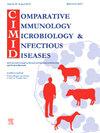Toward assessing serodiagnosis of Q fever in high occupational-risk workers
IF 2
3区 农林科学
Q4 IMMUNOLOGY
Comparative Immunology Microbiology and Infectious Diseases
Pub Date : 2025-10-01
DOI:10.1016/j.cimid.2025.102405
引用次数: 0
Abstract
Q fever, a zoonotic disease caused by the bacterium Coxiella burnetii, occurs in acute or chronic forms in humans. Diagnosing acute and chronic Q fever relies mainly on detecting antibody titers against phase II and I antigens by indirect fluorescent antibody test (IFAT), the reference standard test. This study assessed the seroprevalence of anti-Coxiella burnetii antibodies by IFAT in 269 high occupational-risk workers along with the accuracy of an enzyme-linked immunosorbent assay (ELISA) and a chemiluminescent immunoassay (CLIA), routinely used in diagnostic laboratories, compared to IFAT, in detecting both IgM and IgG against phase II and I antigens. The overall seroprevalence in the screened population detected by IFAT was 55 %, including one case with phase I IgG titer > 1:1024 (possible chronic form) and three cases with phase II IgG titers > 1:128 (possible acute form). The seroprevalence recorded by the three tests varied from 36.8 % (IFAT) to 57.2 % (CLIA), up to 78.1 % (ELISA) for phase II IgG. Similarly, phase II IgM and phase I IgG were detected in 3 % and 22.7 % by IFAT and 27.9 % and 39 % by ELISA. ELISA presented high sensitivity (100 % and 96 %) and negative predictive value (100 % and 93.2 %) in detecting phase II IgM and IgG, respectively. Conversely, ELISA and CLIA presented the lowest specificity (i.e., 32.4 % and 55.3 %, respectively) in detecting phase II IgG. These findings suggest that the results of ELISA and CLIA should be confirmed by IFAT, being useful in discriminating between acute, chronic, and past disease, when risk factors (e.g., employment in high-risk occupations) and/or clinical signs for Q fever are suspected.
高职业风险工人Q热血清诊断的探讨
Q热是一种由伯氏克希菌引起的人畜共患疾病,可在人类中发生急性或慢性形式。诊断急慢性Q热主要依靠参考标准试验间接荧光抗体试验(IFAT)检测II期和I期抗原的抗体滴度。本研究评估了269名高职业风险工人使用IFAT检测抗伯纳氏杆菌抗体的血清阳性率,以及诊断实验室常规使用的酶联免疫吸附测定法(ELISA)和化学发光免疫测定法(CLIA)在检测II期和I期抗原IgM和IgG时的准确性。IFAT检测筛查人群的总血清阳性率为55 %,其中1例ⅰ期IgG滴度 :1024(可能是慢性型),3例ⅱ期IgG滴度 :128(可能是急性型)。三种检测方法记录的血清阳性率从36.8% % (IFAT)到57.2% % (CLIA),高达78.1% % (ELISA)。同样,IFAT检测ⅱ期IgM和ⅰ期IgG的阳性率分别为3 %和22.7 %,ELISA检测的阳性率分别为27.9 %和39 %。ELISA检测ⅱ期IgM和IgG的灵敏度分别为100 %和96 %,阴性预测值分别为100 %和93.2 %。相反,ELISA和CLIA检测II期IgG的特异性最低(分别为32.4% %和55.3% %)。这些发现表明,当怀疑Q热的危险因素(如高危职业)和/或临床症状时,ELISA和CLIA的结果应由IFAT证实,有助于区分急性、慢性和既往疾病。
本文章由计算机程序翻译,如有差异,请以英文原文为准。
求助全文
约1分钟内获得全文
求助全文
来源期刊
CiteScore
4.60
自引率
0.00%
发文量
102
审稿时长
40 days
期刊介绍:
Comparative Immunology, Microbiology & Infectious Diseases aims to respond to the concept of "One Medicine" and to provide a venue for scientific exchange. Based on the concept of "Comparative Medicine" interdisciplinary cooperation between specialists in human and animal medicine is of mutual interest and benefit. Therefore, there is need to combine the respective interest of physicians, veterinarians and other health professionals for comparative studies relevant to either human or animal medicine .
The journal is open to subjects of common interest related to the immunology, immunopathology, microbiology, parasitology and epidemiology of human and animal infectious diseases, especially zoonotic infections, and animal models of human infectious diseases. The role of environmental factors in disease emergence is emphasized. CIMID is mainly focusing on applied veterinary and human medicine rather than on fundamental experimental research.

 求助内容:
求助内容: 应助结果提醒方式:
应助结果提醒方式:


